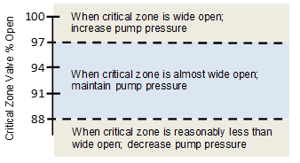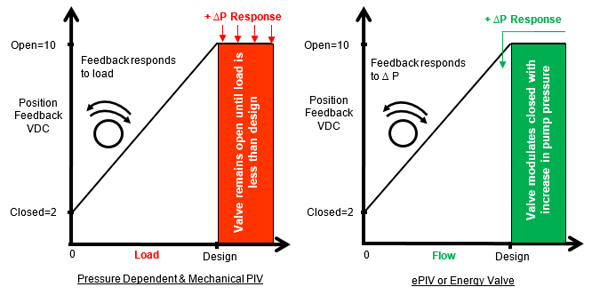Critical Zone Reset Logic Increases Pumping Efficiency
Hydronic variable flow systems may reset supply water temperature, pump static pressure, or a combination of both to reduce plant energy consumption and to comply with building codes and standards. The information below illustrates how valve position feedback to the Building Automation System (BAS) is used to reset the pump pressure setpoint in accordance with ASHRAE 90.1 and California Title 24.
- ASHRAE 90.1 (2016) Section 6.5.4.4 states “Where DDC is used to control valves, the set point shall be reset based on valve positions until one valve is nearly wide open or setpoint limits of the system equipment or application have been reached.”
- California Title 24 (2016) Section 140.4 (k) B.ii. states “For systems with direct digital control of individual coils with a central control panel, the static pressure set point shall be reset based on the valve requiring the most pressure, and the setpoint shall be no less than 80 percent open.”


Only the ePIV or Belimo Energy Valve position feedback signal will work as intended when fully open causes the CZR logic to increase the pump pressure. In response, the critical zone’s ePIV or Energy Valve actuator will move the valve position to less than full open for all load conditions, including design load. In contrast, a pressure dependent control valve or mechanical pressure independent valve (PIV) will stay fully open at design load, regardless of increased pump pressure, which would increase energy cost.
Critical zone reset systems require an advanced BAS installation that can analyze and quickly communicate the actuator position of the ePIV or Energy Valve. However, one anomalous feedback signal can upset the whole system. Any outlier zones should be corrected during the commissioning process or deleted from the CZR algorithm. Additionally, the BAS should remove valves from the CZR logic when the AHU is off, i.e., chilled water valves may be commanded full open under low-temperature conditions to mitigate freezing risk. Otherwise, the variable speed system will run at maximum speed; energy will be wasted, and the pump head pressure will be high.
The ePIV and Energy Valve's position feedback signal is uniquely suited to reset pump pressure. They are the only control valves that behave just like a VAV box actuator in AHU systems.

